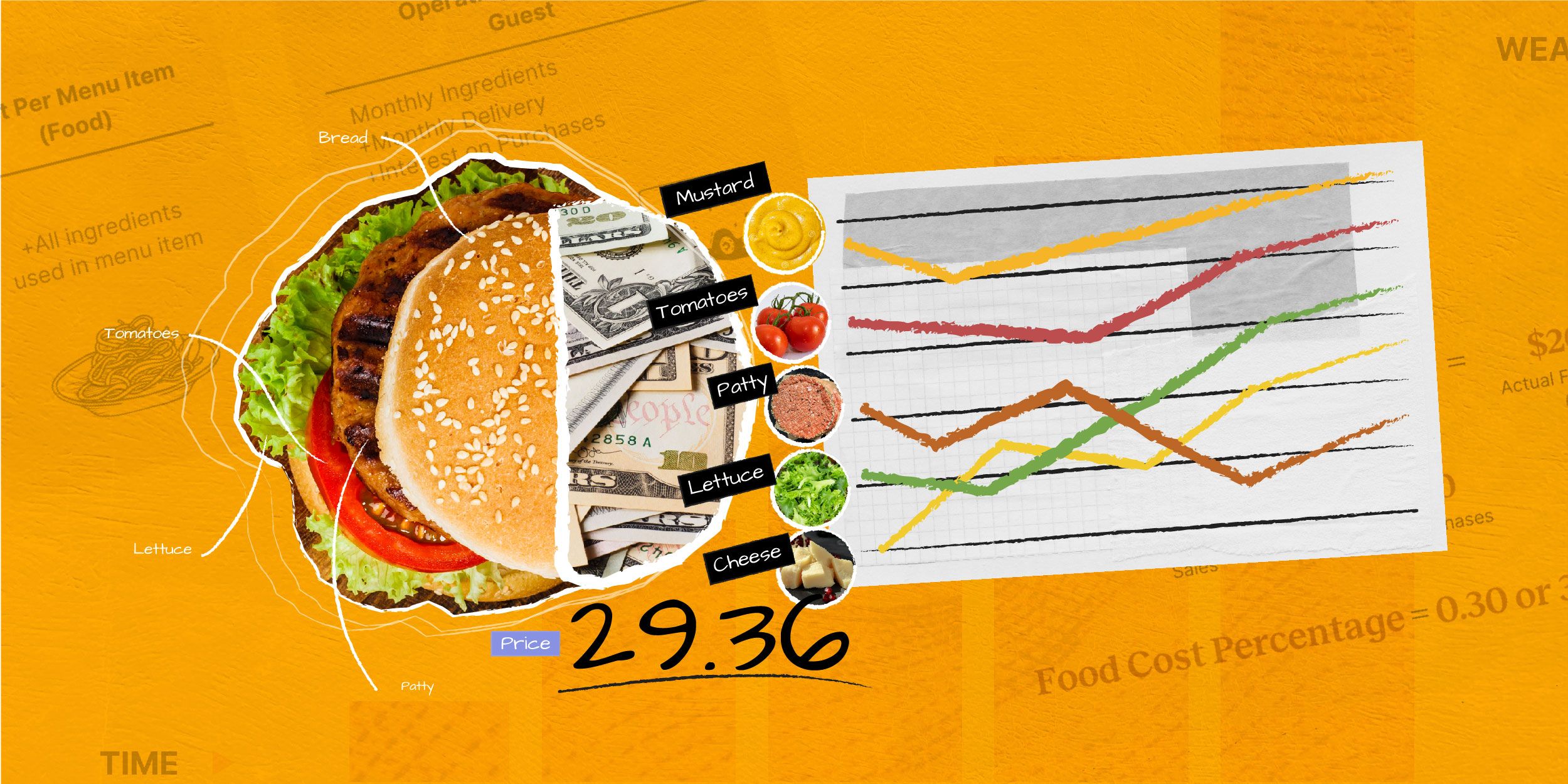How to Calculate Menu Costing

Setting prices for dishes on a restaurant menu is one factor that determines the restaurant’s success. And finding a reasonable price that is comfortable for the consumers and profitable for the restaurant can be challenging. Setting prices too high might discourage customers from ordering, and setting them too low might cause the restaurant to close up.
So, how can the art of restaurant pricing be mastered? And how can they set prices that cover expenses and keep the restaurant financially healthy?
One important thing to understand is the food cost percentage. This shows how much sales go towards buying ingredients and supplies. By keeping track of this, restaurants can set prices that maximize profits. Therefore, this article will reveal how to calculate and use your food cost percentage to set menu prices.
Meaning of Restaurant Food Cost
Restaurant food cost is how much money a restaurant spends on buying ingredients compared to how much it makes from selling dishes made with those ingredients. It's usually shown as a percentage called the food cost percentage.
Some restaurants use food costs to figure out how much it costs to make a dish, while others use a method called Cost of Goods Sold (COGS), which includes all the expenses for making a dish, like ingredients and even small things like napkins. Both ways help restaurants manage costs and remain profitable.
Important Steps to Take Before Calculating Food Costs

Keeping track of a restaurant's finances is really important for making sure it stays successful. Restaurants don't just make a budget once and forget about it. They need to check it regularly to see how things are going. Even if numbers seem tricky and confusing, some tools, like accounting software, can help them manage everything easily. If a restaurant uses a POS system that tracks inventory and purchases, syncing it with its accounting software can make things even simpler.
However, if they prefer to do things manually, they must keep track of all the numbers, like how much they spend versus how much they make, set clear goals for their budget to help them run smoothly, pay attention to their weekly budget to better control their expenses and keep their business on track, and also decide how often they want to look at their finances, like every three to four weeks.
Meaning of Food Cost Percentage
Food cost percentage shows how much money is spent on food compared to what is earned. This is usually shown as a percentage and is expected to help restaurants decide how much to charge for their food.
To figure out the food cost percentage, you need to know these things:
- Beginning inventory value: How much was the food inventory worth at the start of the week?
- Purchases: How much more food was bought during the week?
- Ending inventory: How much leftover food there is at the end of the week.
- Total food sales: How much money was made from selling food during the week?
With these numbers, restaurants can work out their food cost percentage, which helps them decide on prices and manage their business better.
Food Cost Percentage Formula
The formula for calculating the food cost percentage is:

So basically, you add how much your starting inventory and purchases cost. Then, subtract what's left in your inventory at the end of the period. Finally, divide that number by how much money you make from selling food.
For example, if Mr. Adam, the owner of Ace Pizza Place, has a beginning inventory value of $10,000, purchases of $6,500, an ending inventory value of $14,000, and total food sales of $7,000. His restaurant food cost percentage would be calculated as follows:
Food cost percentage = (10,000 + 6,500) – 14,000 / 7,000
Food cost percentage = 16,500 – 14,000 / 7,000
Food cost percentage = 2,500 / 7,000
Food cost percentage = 0.357, or 35.7%
Ace Pizza Place's food cost percentage is 35.7%. This means they use 35.7% of their revenue to cover the cost of ingredients. However, Mr. Adam wants to be sure if he still needs to make some changes to his menu. So, he calculated the ideal food cost percentage and compared the result to his actual food cost percentage.
Calculating the Ideal Food Cost Percentage
Before calculating the ideal cost percentage, you must have identified the total food costs and the total food sales of the restaurants. For example, if the total food cost of the restaurant is $2,000 and the total food sales is $7,000. You will then calculate the ideal food cost by dividing the total food cost by the total food sales.

Ideal Food Cost = $2,000 / $7,000
Ideal Food Cost = 0.286 or 28.6%
From the calculation, it is clear that Steakout restaurant's ideal food cost is 28.6%, so if the restaurant's actual cost percentage is 35.7%, that means the restaurant is missing out on 7.1% in revenue.
Ideal Food Cost Percentage
While many restaurants aim for the perfect food cost percentage, the reality is that it doesn't exist. Food cost percentages vary significantly depending on factors such as the restaurant's cuisine, ingredient quality, and daily operational expenses.
Rather than focusing on unattainable perfection, restaurants should prioritize achieving a healthy food cost percentage tailored to their menu, ingredients used, and customer preferences. By understanding this, restaurants can better optimize their financial performance and overall success. However, keeping the food cost between 25% and 35% of revenue is advisable to ensure restaurants remain profitable.
Generally, if a restaurant has higher expenses, it might need to charge more for its food.
For example, a restaurant that serves caviar might spend about 40% of its money on food because caviar is expensive. However, a pizza place might spend around 25% because dough and sauce are inexpensive. Each restaurant needs to figure out its expenses, which will determine its food cost.
Food Cost Per Serving

It is important to determine the cost of every item on the menu to determine the food cost per serving. The food cost per serving for a restaurant is calculated as the sum of the ingredient costs per serving.
Here is a simple explanation of how it is done.
Adam, the owner of Ace Pizza Palace, wants to calculate the cost per serving for his signature Pepperoni Pizza. The pizza is made with 12-inch pizza dough, 1/2 cup of marinara sauce, 1 cup mozzarella cheese, and 20 slices of pepperoni.
Adam purchases his ingredients in bulk and pays $10 for a pack of 10 pizza doughs. He figures out that one 12-inch pizza dough costs his restaurant $1.00. Adam goes through a similar process to determine the cost per serving for the remaining ingredients in the pizza.
One pack of 10 pizza doughs = $10.00
1 pizza dough = $1.00
1/2 cup of marinara sauce = $0.20
1 cup of mozzarella cheese = $0.80
20 slices of pepperoni = $1.50
Cost per serving = $1.00 + $0.20 + $0.80 + $1.50 = $3.50
Importance of Cost Per Serving
Knowing your food cost percentage is really important for running a successful restaurant. It helps restaurants make decisions about pricing, dish profitability, and overall costs. Understanding your food costs also means you can price your items correctly, try new recipes based on data, and make smart changes to your menu.
Plus, analyzing your best sellers and under performers helps restaurants optimize their menus for profit. If you have multiple locations, knowing the food cost percentage for each helps restaurants understand their performance and make better decisions. Basically, understanding food cost percentages is essential for managing your restaurant effectively.
Setting Menu Prices
The menu price is how much you charge for food at your restaurant, and this is determined by using the formula:

Mr. Adam's Ace Pizza place cost per serving is $3.50, while his ideal food cost is 28.6%.
Therefore, the ideal menu price is $3.50 / 0.286 = $12.24
Which means Mr. Adam must sell each burger for $12.24 if he wants to run his business at his ideal profit margins.
Tracking Menu Pricing Effect on Sales
Successful restaurants regularly track menu prices and sales, adjusting them as food costs change. Mr. Adams now knows that his pizza should be sold at $12.24 if he wants to remain in business. On the other hand, if sales slow down, Mr. Adams could strategise by partnering with cheaper vendors or adjusting portion sizes to justify a price reduction, but if sales increase, he could aim for a higher food cost percentage to increase the price.
However, keeping track of your costs can be time-consuming. Using menu costing tools like Open Pantry’s Restaurant Pro Suite can automate this process so you can view the live costing of any recipe at any time. With other added tools like live inventory, accounting integration, and reporting, it's the easiest way to manage your restaurant.